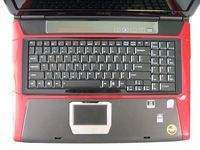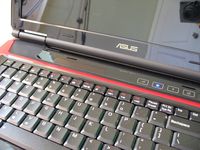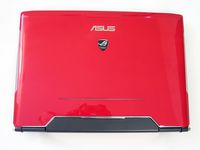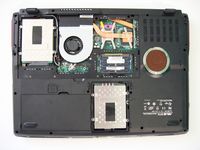SLI & Centrino 2: Gaming Laptops Battle
ASUS G71 Republic Of Gamers: Look And Feel
We’re going to get a bit subjective here. If you’re familiar with ASUS’ RoG motherboards, then you already know it puts a particular emphasis on flashy looks to go along with home-brewed software and a generally higher-end list of hardware. On an enthusiast motherboard, the LED lighting, convenient buttons, and extravagant cooling go a long way to enhance aesthetics. That’s all a bit harder to pull off on a laptop, though. Alienware definitely rocks the “understated class” motif much more effectively.
With that said, ASUS does a fantastic job with its paint scheme. The pearlescent red paint job proves very scratch-resistant and is an exceptional choice for masking fingerprints and small nicks. We could do without the silver accents splashed about, given that black is the second most dominant color and three tones look quite a bit busier than two. Additionally, once the system is powered on, a series of red and blue LEDs add to the LAN party ambiance.
The G71’s shape is superior to the Clevo designs used by Eurocom and Killer Notebooks. And at just over eight pounds, it’s a pleasure to haul around compared to the submissions from either Alienware or Killer Notebooks (we are assuming you’ll be carrying these gaming laptops around with you to some degree).
As with the two whitebooks, ASUS is guilty of drawing air up through a fan at the bottom of the chassis. So you’ll probably not want to game with the machine resting right on your lap. In fact, ASUS adds a pair of pads towards the back of the shell to make sure there’s always airflow while the G71 is on a flat surface.
Pop the notebook open and you’ll look at a full-sized keyboard, complete with the 10-key number pad seen on our other 17” gaming platforms. The touchpad feels decidedly bolted-on, but ASUS, recognizing that gamers have no desire to use touchpads anyway, provides a software tool to disable it on demand.
Making It An ASUS
ASUS is adamant that anyone can take a bunch of off-the-shelf components and create his or her own mobile gaming machine. Where the seasoned motherboard vendor sets itself apart is the software backing its hardware package. For example, the bundled Direct Console application offers a couple of overclocking options above and beyond the T9400’s stock 2.53 GHz: 2.65 GHz and 2.78 GHz. Direct Console also controls the onboard LED lighting and OLED—used to monitor CPU/memory usage, battery charge, email, and instant messages.
Get Tom's Hardware's best news and in-depth reviews, straight to your inbox.


The G71 also feature Express Gate, ASUS’ near-instant boot Linux environment with access to the Internet, a media player, Skype, and a photo album. This isn’t really a feature we see being heavily used on the desktop, but it does make great sense on the road, where you might want to check email or a stock quote without fully booting into Vista.
Current page: ASUS G71 Republic Of Gamers: Look And Feel
Prev Page ASUS G71 Republic Of Gamers: Hardware Next Page Killer Notebooks’ 17.1” Odachi: Hardware-
kitsilencer From a money point of view, it's never going to make sense buying a gaming laptop. Scaled down performance and inability to upgrade are issues.Reply
But it sure as hell feels good having one ^___^ -
neiroatopelcc http://www.tomshardware.com/reviews/gaming-notebook-roundup,2023-6.htmlReply
"shipped the system with a 64-bit copy of Vista Ultimate (Alienware included x32 Home Premium)." -
ap90033 4 Grand? Are you guys nuts? I would say that right there would rule out about 90% of us normal gmaers..Reply
Besides the gaming scores looked weak imo..
I personally thought it was a better idea to go get a Gateway P7811FX with a single Geforce 9800GTS. It plays Call of Duty at 1920x1200 max settings around 50FPS. AND it cost me ONLY $1249 (Plus Best Buy let me pick any game I wanted for FREE!) -
agree with kitsilencer, gaming laptop is never practical.Reply
even with a beast graphics card, you'd be pretty hard to get more than 2 hours of shitty performance.
get a gaming desktop and perhaps an EEE or iPhone for travelling. my iPhone has 20+ games and enough media (don't forget TV connector for watching films in hotels) to keep me busy for more than one week away from my gaming rig. -
ap90033 Not true my "Gmaing Laptop" is great at LAN Parties and I play it for 6-8 Hours straight there...Reply
I think maybe you had a bad experience with a laptop that claimed to be a "gaming" laptop. I bought one before like that and it have an 8600M Geforce and it Sucked bad... If you get a good laptop with say a 9800gts or so you would be suprised... -
GlItCh017 ap900334 Grand? Are you guys nuts? I would say that right there would rule out about 90% of us normal gmaers..99.90%Reply -
ap90033 PS gaming laptops hold value much better than desktops. I had one I paid 1250 for, had it for a year, then sold it for $1100 and bought the newer "upgraded" model that just came out for $1250. I got an Upgraded CPU (From Core 2 1.67 GHZ to Core 2 Centrino 2 2.26 GHZ), Memory (from 3 Gigs DDR2 667MHZ to 4 Gigs DDR3 1066MHZ), Hard Drive (faster), Video Card (from 8800gts to 9800GTS), Screen (from 1440x800 to 1920x1200) and OS (From 32 bit to 64 bit). Not bad upgrade for $150 or so!Reply


